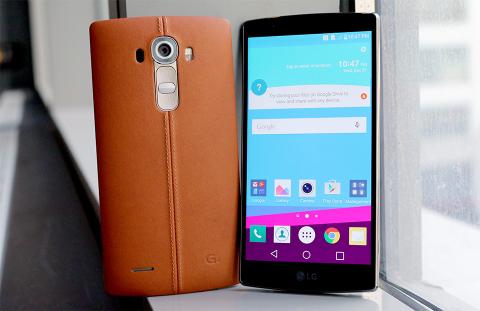LG G4 with SlimPort 4K: Sharp and shooter
Flagships get better with every generation but some of last year's are as good as reborn. The LG G4 improves on the three best features of its predecessor: design, screen, the camera - and does so decisively. It adopts a G Flex curve, but makes it its own with an optional stitched leather back, and has what may as well be the most advanced camera module on a phone yet.

The camera really is the new phone's key feature. LG picked a new 16MP sensor, improved the optical stabilization, gave it a wider aperture lens, added a handful of new software features (including manual mode) and placed a top-notch selfie camera on the front. A complete overhaul of the imaging department.
LG designers were hard at work too. They gave the LG G4 a subtle arc that complements the spacious screen and sourced high-quality materials for the back covers. The premium option is made of genuine full grain leather with threads imported from Germany used on the decorative stitching. Even the basic backs are far from plain - the white one has ceramic coating.
The LG G4 strikes a great balance between tangible quality and intangible class. Here's how the hardware capabilities and the premium exterior balance out, plus what the G4 offers over its predecessor.
Key features
Subtly curved design with optional leather backs
5.5" QHD (1440 x 2560px) Quantum Display IPS LCD, 534ppi, Gorilla Glass 3
Android 5.1 Lollipop with the latest LG UX v4.0
Qualcomm Snapdragon 808 chipset with hex-core processor (dual Cortex-A57 @ 1.82GHz, quad A53 @ 1.44GHz), Adreno 418 GPU and 3GB of RAM
16MP camera, phase detection/laser autofocus, dual-LED (dual tone) flash, OIS, 2160p video recording
8MP front-facing camera, 1080p video recording
32GB of built-in storage, expandable via a microSD card slot
Active noise cancellation with a secondary microphone
Dolby mobile sound enhancement
3,000mAh user-replaceable battery
microUSB 2.0 with SlimPort 4K
IR-port and NFC
The screen is LG's own creation as none of the top display manufacturers had what the G4 needed. The company calls it a "Quantum Display," not be confused with Sony's quantum dot screens. LG says it's actually better. The new components reduce power usage, while improving brightness and contrast. Better color accuracy is promised as well.
Design and build quality
The LG G4 can easily be mistaken for the LG G Flex2, the two look so much alike and are basically the same size and weight. The Flex2's curve is definitely more prominent though and if that doesn't give it away, snapping on a leather back on the G4 will set these two even further apart.
While the body of the LG G4 is arced, the G3 forms appear softer, rounder. LG squared off the four corners and the left to right curve of the G3's back is more pronounced. The impression of angles and corners on the LG G4 is furthered by the sides, which are angled inward at the front.
This improves grip as it gives your fingers a ledge besides the screen. However, the way the opposing front and back curvatures work out creates a hard, pointed frame around the phone, which can dig into your palm if you grip harder. And you may have to as the glossy material of the frame is slippery, the smooth plastic on the back doesn't help much either.
LG G4 doesn't feel bigger, but is grippier than its predecessor
The G4 is a large phone, but we got used to it fairly quickly - we forget it's in our pockets and it doesn't feel humongous in the hand (well, the screen does). The phone feels rock solid, which also means it doesn't bend like the G Flex2 (granted, a desired effect there). The weight is well-distributed with the balance shifted slightly towards the bottom. You can hold the G4 low and it won't topple over.The LG G4 looks a bit like a TV with no clear indication of up or down, left or right. The G3 had a lighter colored strip at the bottom, which gave it a sense of direction, but the G4's all-dark front looks borderless.The glass (Gorilla Glass 3) and screen below it are slightly arced, it's so subtle that you may not see it immediately. You can feel it though, the 5.5" screen is quite large and the concave shape makes the top and bottom parts feel closer to your finger.
The new 16MP camera in the traditional G-series arrangement
The loudspeaker is at the bottom left. The back can be removed to access the battery, the microSIM and microSD slots. The card slots are blocked by the battery. Here you'll notice several pogo pins, two of those are for NFC, the rest for the optional wireless charging covers.The face of the phone is pretty plain, but it does have a hidden gem - the 8MP/1080p selfie camera. The earpiece, along with the usual sensors (proximity and ambient light), are also here.
The bottom of the phone holds the mouthpiece, the 3.5mm audio jack and the microUSB 2.0 port. It's SlimPort-enabled and with the right adapter (or compatible TV) the LG G4 has wired 4K video output.The top of the phone holds the noise-cancelling mic and an IR blaster if you want to control your TV wirelessly. The sides of the phone are bare, except for a small notch that helps you pop the back open.
Display
LG caused a collective jaw drop last year when it announced that its new flagship phone will have a massive, incredibly sharp screen - 5.5" at QHD. It kept those measurements for 2015 (there's really no sane way to increase them further) and worked hard to improve the image quality.The new Quantum Display is similar to Sony's Triluminos display, both companies competing in the TV panel business. LG turned to DCI (which normally works with TV studios) to calibrate the LG G4 display, achieving 98% coverage of the DCI standard, which means accurate colors with no oversaturation. The Quantum Display fixes both of those niggles. Colors are vivid (but not oversaturated) and viewing angles are perfect. The display is marginally dimmer (hard to notice without measurement equipment), but black levels went down which pushed contrast way up.
Connectivity
The LG G4 comes with the full connectivity suite. It has 4G LTE for up to 300Mbps of download and up to 50Mbps of upload and 3G HSPA+ (42.2Mbps/5.76Mbps) when you're outside of 4G coverage.
Wi-Fi 802.11ac is no surprise, you can use the latest Wi-Fi routers at home at either 2.4GHz or 5GHz. There's also Bluetooth 4.1 with Low Energy mode and apt-X for better audio streaming.
NFC is on board as well. For file sharing you can use ShareBeam, which is LG's take on Android Beam.
For wireless multimedia streaming there's DLNA and Miracast (which can mirror your phone's screen). There's also the wired option with SlimPort 4K, which lives in the microUSB 2.0 port.
For old-school TVs you can use the IR blaster and QRemote. The app can also control audio equipment, projectors and air conditioners.
